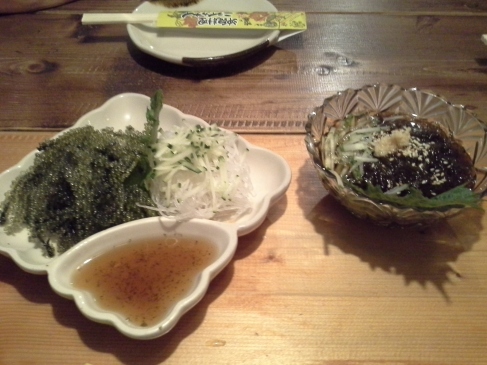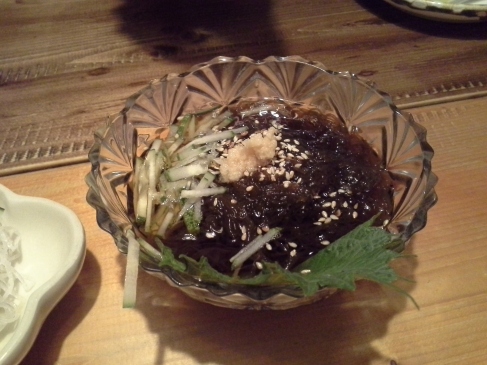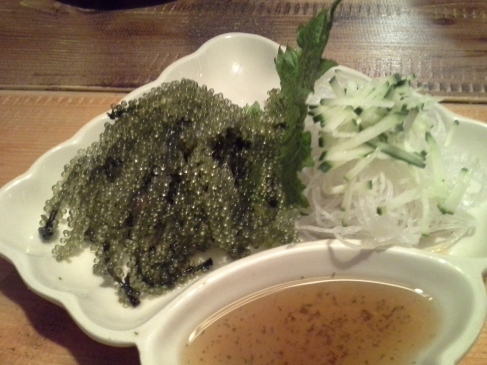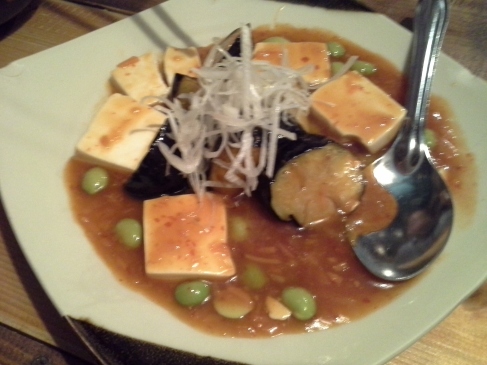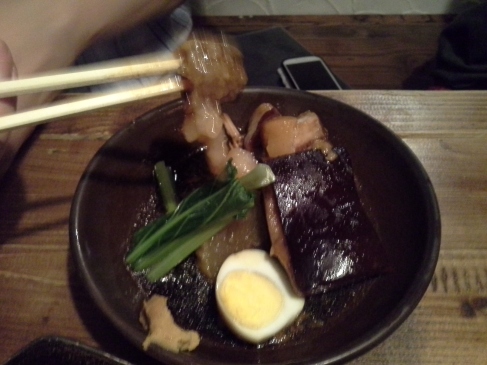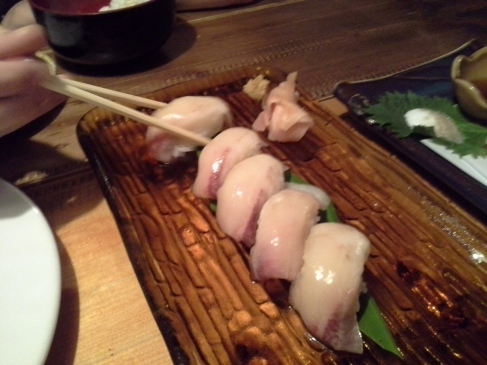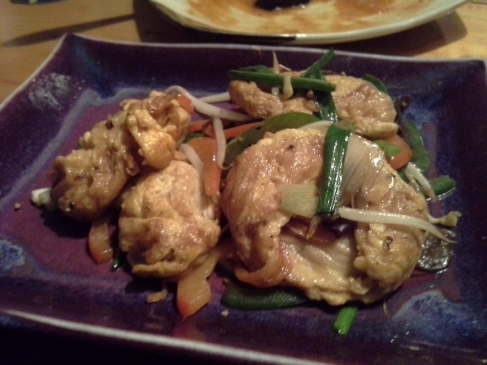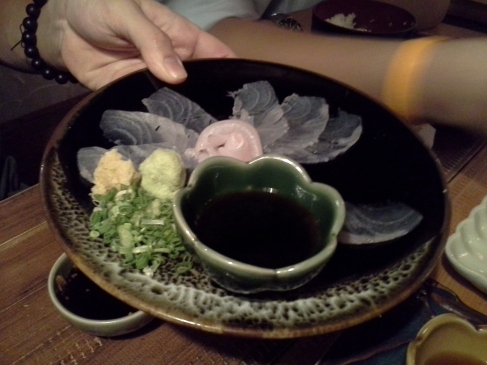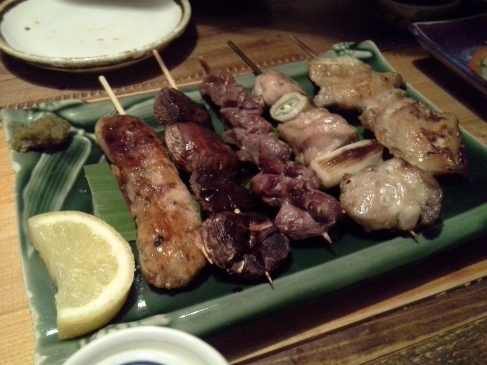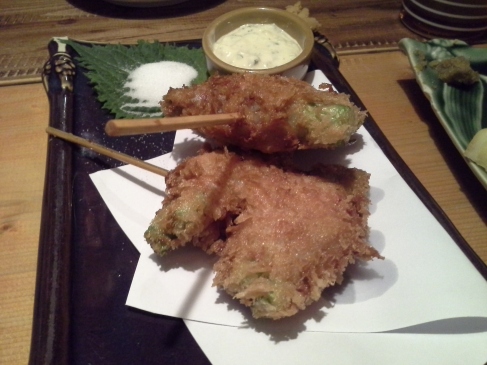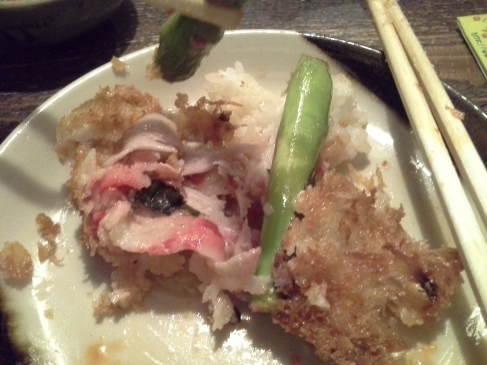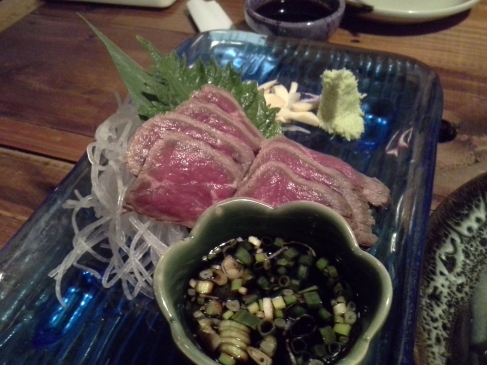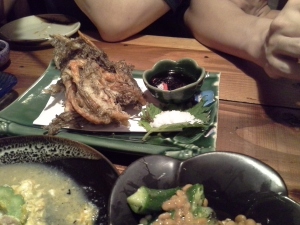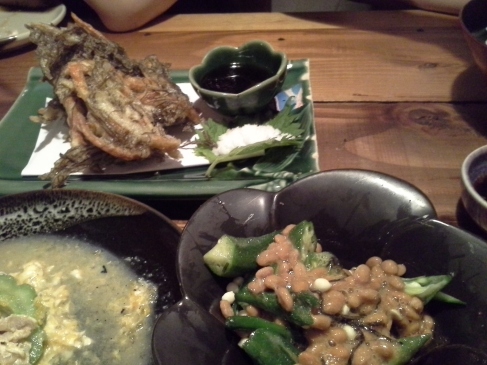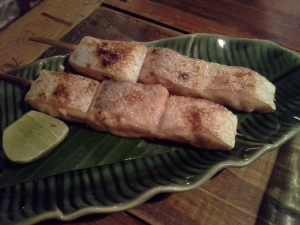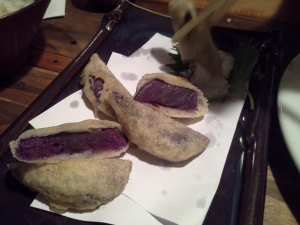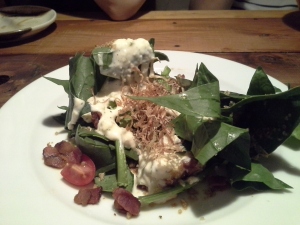I'm not obsessive nutrition compulsive.
Okinawan diet
Okinawan restaurant – “Nirai Kanai ” revisited, finally getting to try the sea grapes, aloe vera sashimi and the famous collagen pork. And also the secret in their healthful diet finally unveiled??
*This post was written on Saturday, before the anti-government close-downs in Bangkok*
Yes, as promised, I went once again to the Okinawan restaurant on the adjacent street to my house’s street. This time, (since I am blogging about the restaurant again, post here: https://obsessivenutritioncompulsive.wordpress.com/2014/01/07/the-okinawan-living-secret-to-long-life-is-in-their-food-japanese-okinawan-restaurant-review/), I thought I would come more equipped with additional info for those who have become enticed by what this restaurant is about.
First off, something you should know when walking into a ‘foreign food’ restaurant with a name you do not understand: learn what the restaurant’s name really mean. “Nirai Kanai” means a “heavenly place where there is only happiness”. It is also a reference to the mythical utopia/origin of life in Ryukyuan Shinto religions.
And if you were wondering why an ‘Okinawan’ restaurant was referencing the ‘Ryukyuan’ (?) customs, that is because Okinawa Prefecture is the Ryukyu islands.

A very handy map showing where Okinawa Prefecture is.
A little more info on Okinawa Prefecture…
Wikipedia:
Okinawa Prefecture is the southernmost prefecture of Japan.[1] It comprises hundreds of the Ryukyu Islands in a chain over 1,000 kilometres (620 mi) long. The Ryukyus extend southwest from Kyūshū (the southwesternmost of Japan’s main four islands) to Taiwan. The Okinawa Prefecture encompasses the southern two thirds of that chain. Okinawa’s capital, Naha, is located in the southern part of Okinawa Island.[2]
And according to my brother’s friend (we were having a farewell dinner for my brother flying back to the States after a semester holiday, so there were my parents, brother and I, and two of his friends) who was half Japanese, ‘Okinawa’ used to be its own ‘nation’ for a while. After a bit of snooping around on the internet, I found out that the Okinawa Prefecture had actually only become a part of Japan in 1879.
Before that, the Okinawan islands, which were quite close to China (and Taiwan) had a ‘tributary’ relationship with China. No wonder then, that the cuisine of the Prefecture would have elements of Chinese in it as well (e.g. bitter gourd stir-fries, the use of eggplants in its dishes).
But anyway, I walked into the restaurant with the determination to finally try the infamous ‘taco rice’ (rice topped with minced pork, sunny-side egg, veggies and avocado), but looking at the circumstance, a late farewell dinner with friends; ordering a random individual dish wasn’t going to be an option.
Because we were so hungry, we immediately ordered ‘appetizers’: two types of Okinawan seaweeds.
“Sunui Usachi” or Okinawan seaweed – Mozuku – seasoned with a sweet and sour sauce, served cold. The seaweeds were topped with pan-fried (with no oil) sesame seeds (I always love it when restaurants actually put the efforts into pan-frying their sesame seeds topping. There is such a huge distinction of flavours between the smokey aroma of slightly roasted sesame seeds to stale ones you sprinkle out from a packet. The process of pan-frying creates such a dynamic of flavours that adds an ‘umph’ to the dish, so doing so makes a lot of difference). Also topped with some sliced cucumber, ground ginger and decorated with a sesame leaf.
The restaurant uses a lot of sesame leaves for their garnish (but I just eat them anyway). Like the seeds, sesame leaves have a distinct flavour. It is slightly herbal/aromatic. I only learned to consume sesame leaves from Korean family friends; unlike the Japanese, Koreans consume a large amount of sesame leaves as veggies (either in stir-fries, or for wrapping foods). Sesame leaves are quite similar in nutritional contents to the seeds i.e. calcium; I would treat it like green, leafy vegetables (in terms of garnering nutrients from them), but eating large quantities of a herb-like veggie is still a bit extreme for me… (although dried herbs are a very concentrated source of nutrients).
But anyway, the Mozuku seaweeds had a very soft, slippery texture; one could compare it to soba noodles that is very soft, almost like jelly. However, I would say the texture was really more like ‘mung bean noodles’ or ‘Japanese konnyaku noodles’ (zero-calorie noodles). It is pretty tasteless, and hence the use of strongly seasoned sauce which it comes floating in.
The “mozuku seaweed” along with most edible seaweeds, have always been a vital mineral-dense source of nutrients for vegans/vegetarians (of vitamins and minerals that are mostly found in animal products i.e. vitamin B’s, iron, calcium, amino acids, etc). Seaweed has even been claimed to have cancer-fighting properties, and some types are an alkaline food (balances the levels of acid in your body).
To me, seaweed had just always been this super healthy, strips of slippery green (a healthfood). For example, kelp (a type of seaweed), takes the place as one of the superfoods out there. Perhaps seaweed is an element of the Japanese diet that gives its people such long-life!
Then we’ve got the infamous ‘sea grapes’ or “Umibudo“! I was led to believe by my dad that umibudo was a special Okinawan delicacy, when, in fact, umibudo is a common Japanese ‘beer snack’ enjoyed nationwide, not just in the Ryukyu Islands (How can the Japanese not be so healthful when even their bar snacks menu feature nutrients-dense seaweeds?).
Umibudo is definitely one of the dishes at the Okinawan restaurant that jolted me with its distinct flavour and texture – a totally new eating experience even for someone like me who can stomach nearly every foods, as long as it’s natural. This seaweed’s other name is ‘sea caviar’ and I would agree that this alternate title summarizes its flavour: their tiny circular beads (most likely filled with seawater – hopefully not unsanitary!) pops in your mouth like droplets of salted water, and the soft stems are slightly crunchy in a way. It is much lighter to the tastebuds than caviar and (animal cruelty free!), less salty, but it is definitely very “fishy” or “sea” tasting, as if they had just hauled the weeds up from the bay (better than eating fertilized fish eggs though!)
Mozuku seaweed was served with a sweet and sour vinegar sauce that elevated flavours of the dish that would be otherwise bland.
Then another dish we also finally had the chance to try (ran out last time we came) was “Mabo tofu” made with Okinawan style eggplant (which was pretty much like normal eggplants), soft tofu, and some edamame beans (originally also including pork mince which we had omitted to cater for my veggie mum). Another thing I like about this restaurant is their readiness to prepare non-meat meals for my mum.
To be honest, this “Mabo” dish wasn’t all that impressive despite all the hype (just my presumption from looking at the mouth-watering menu photo that it would be very strongly flavoured like the Chinese mapo tofu). The thick sauce had a very mild chilli flavour, and was slightly sweet and salty. The mabo (Japanese way of saying “Mapo” – apparently they can’t pronounce “p’s” very well) was very light which is not the impression of a piping hot, oily, typical Chinese mapo tofu engrained in my mind through tongue numbing experiences I have often been handed with. I guess the fact that the dish is not too oily and heavily seasoned is a good Okinawan lesson of moderation.
I loved the thick slices of eggplant used in the Mabo though (still retained its eggplant texture and flavours, rather than stir-fried to mush as many restaurants do). I suspect the eggplant has been lightly steamed then stir-fried with a bit of oil before being poured on top with the mabo sauce.
Then of course, the “Rafute” pork which we had refrained from ordering last time, due to that lunch time’s recent encounter with an equally gelatinous pork dish (we were still ‘queasily’ reminiscing at that time). This dish however, was not the collagen pork (the restaurant’s signature dish for female diners) I was talking about in my previous post, but Rafute was a dish made of pieces of pork simmered slowly in a soup of brown sugar, sake, soy sauce until it is “melt-in-your-mouth tender”. Unlike the collagen pork that uses pig’s feet that is mostly the collagen-rich skin, this menu is mostly fat and bits of meat. Still delicious according to my dad – sweet (a bit too much), salty and very fatty.
My dad also commented about the thickness of the skin, and he suspected they could have used free-range pork (Not too hard to source out in Thailand. What I like about eating meat here is that they are not too ‘artificial’).
Thick skin can indicate the pig was at least not a ‘piglet’ (with soft, tender skin) often slaughtered at a young age in a factory, high-consumer demands setting. The tough texture and gelatinous skin can also indicate exercise.
“Sima sushi” – a special Okinawan style of preparing sushi – it is basically fish that has been lightly marinated in a sauce (I am guessing they may have used the juice from the “gari” or ginger pickling process which is what gives the fish a pretty pink hue… or maybe it was just a pink-fleshed fish…). I thought the fish just tasted a bit like normal pickled raw fish (you know, the pickled tuna sashimi? The silvery coloured ones), but definitely very fresh tasting.
Another vegetarian/vegan dish takes the win! “Vegetables with tofu curd stir fry“.
I have no idea where they had sought out their bean curd, but it was the best one I have ever eaten – soft, juicy and slightly sweet unlike the usual super dried out, tasteless sheets I have eaten. I suspect the tofu curd must have contained a high fat content to give it that plump texture, and have been marinated prior to becoming a component of the stir-fry (for those who do not know, bean curd is basically byproduct of the soymilk-making procedure. Mostly fat and some protein)
I can’t stop gushing about this dish – the bean curd tasted just like eggs (which was the hardest thing to give up when I was vegan). Other than that, the Chinese-style stir-fry was typically cooked in vegetable oil and seasoned with soy sauce (may have also had a bit of mirin in it too, to give the dish a Japanese twist).
“Suzuki no Usuzukuri” or Japanese sea perch sashimi. This dish did not entice me much. Although the sweet vinegar was a refreshing change from the usual soy sauce; I also liked the use of chopped spring onions to cut down the “fishiness”.
What I’ve noticed about the condiments served at this restaurant is that they differ from the usual types served at Japanese restaurants i.e. wasabi, ground ginger, wasabi, crushed white radish.
These new condiments include (the yellow mound next to the wasabi above) this paste that tasted a bit like a mixture of fermented bean curd and miso paste – quite strong tasting. It must have contained fermented bean curd or what you could call “Chinese/Japanese cheese”.
Another Japanese condiment I have never tasted before is this very zingy paste seen below that were served alongside the selection of “yakitoris“. The green paste seemed to have consisted of a lot of salt, lime zest, and perhaps a bit of ginger.
The two strongly flavoured condiments were a good ‘palate cleanser’ between fatty and seafood dishes. Lemon served alongside also have some “detoxing” and “metabolism boosting” qualities (including vinegar). Ginger – ground or pickled have an ‘alkalizing’ property which can balance with the acidity of seafood; it also has antiseptic properties which can help with the easing stomach problems caused by food ‘poisioning’.
Both yakitori or kushiyaki are general terms used to describe skewered foods. The first of the kushiyakis was grilled ‘minced chicken’ – (I highly recommend Japanese dishes using mince because the Japanese are super mince-makers. They know to choose the softest part of the meat, and use just the right ratio of fat to give their minces – whether in patties or meatballs – a very soft, melt-in-your mouth feel. Obviously very fatty as well. At least they used high-quality meat in their burgers though, not something like “pink slime”).
Although this minced chicken was not the best I have had, being not very jelly-like soft (possibly because it did not contain a large amount of fat and tendons. Very Okinawan-ly healthy).
The next yakitori in line was grilled mushrooms brushed with a sweet sauce (possibly soy sauce and mirin): very delicious, the mushrooms were full-flavoured and the sauce was just right; not too sweet or salty (definitely vegan)
Then next to the mushrooms were chicken gizzards – tough on the outside but juicy on the inside.
Then there was the ‘chicken and negi’ yakitori – whose negi or spring onions I totally adored (the Japanese are geniuses at making spring onion pieces tasty on its own. I think the chicken fat that has seeped out on to the negi is what makes them so good, and also the slightly sweet sauces that they brush on top while grilling).
Next to the chicken yakitori was a very fatty piece of grilled skewered pork.
Then we ordered “Buta katsu” – “buta” meaning “pig” and “katsu” meanig “cutlet”. The dish was green asparagus wrapped in thin slices of pork that was later breadcrumbed then deep fried. Very oily but well seasoned; it did not require the tartar sauce it was served with (Alright, the crumbed pork was not as oily as something like potato fries, but I’m just not used to deep-fried foods)
I had to take a photo of the surprise on the inside – I have no idea where the pink came from: obviously not blood because the thin slices of meat would be thoroughly cooked by the hot oil. What they could do to improve (this also goes out to all the restaurants out there) is stop using the ends of the asparagus in their dishes (it is too fiberous for human teeth and non-ruminants).
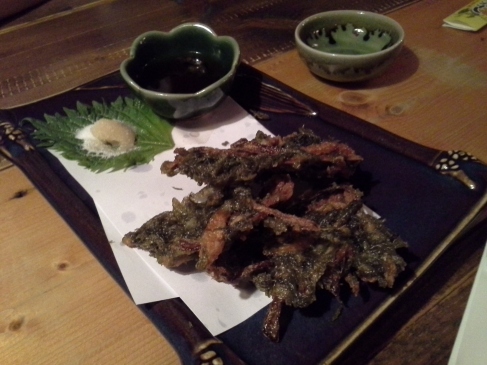
The pictures aren’t really in order here… These deep-fried battered seaweed or “seaweed tempuras” were also a part of our range of ‘appetizers’ although I wouldn’t call oil-drenched dishes appetizers (oil is way too filling and caloric dense for before-meal snacks). The first seaweed tempura is a mixed Okinawan seaweeds tempura.
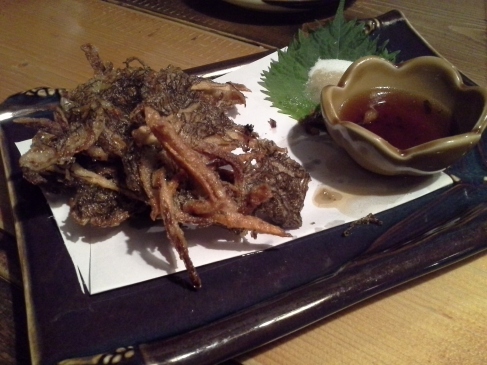
This was mozuku seaweed tempura. I have reviewed this seaweed tempura in my previous post – the seaweeds are so light you can barely feel them with each bite of the puffy fried batters. It is the sweetened tempura dip that makes the flavour of the dish.
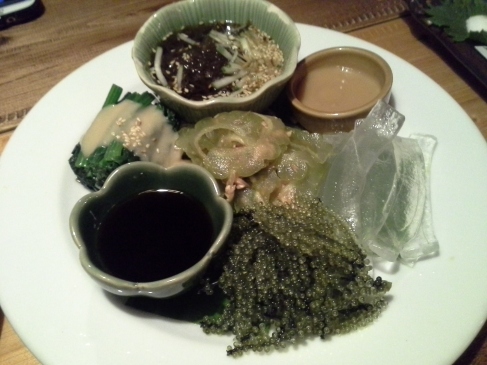
Our other ‘appetizer’ – “Mixed Okinawan vegetables“: clockwise from the top, we’ve got the mozuku seaweed in sweet vinegar sauce, a sweet soy-based dip for the “aloe vera” sashimi which was quite disappointing (taken the price of the aloe vera sashimi *One plate of purely aloe vera sashimi was around 180 Baht* I had the hunch that it would be like tasteless jelly which I was right. Aloe vera meat is only good in sweetened commercial juices – ‘aloe vera juice’ is a popular Asian drink), the sea grapes with its dipping sauce, and some veggie which was either boiled spinach or shanghai veggie (drizzled on top with a soy-based sauce as well). And in the middle was “goya tuna” or thin slices of raw bitter gourd and tuna in a light Japanese salad dressing. The flavour of this bitter gourd salad was just right – a bit sweet and creamy (I think they used a soy dressing).
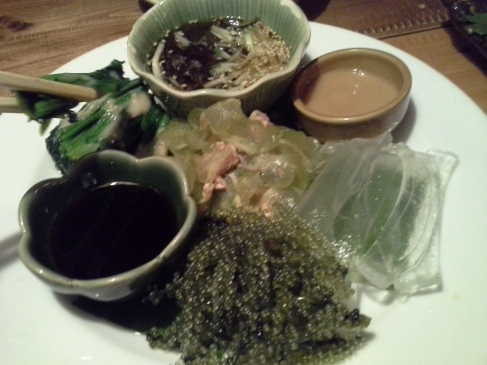
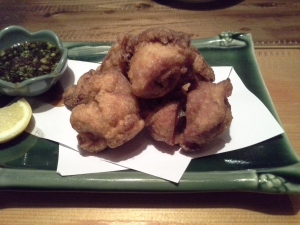
Chicken “Torikaraage” or Japanese fried chicken with Okinawan lemon sauce (a sour sauce with soy sauce and chopped spring onions on top). Nothing special there, just very juicy, pieces of fried chicken.
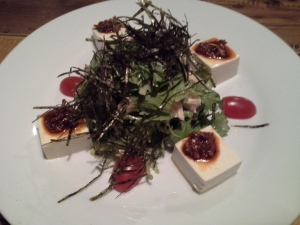
We finished the meal off with a “tofu salad” – mixed salad with very lean and soft pieces of roasted chicken, drizzled with homemade sesame dressing (in fact, the soy-based dressings I have been mentioning may have actually been made of sesame paste or tahini), sprinkled on top with dried seaweed. The soft tofu were topped off with a soybean based chilli sauce.
The sesame dressing had just the right amount of creaminess and slight sweetness: this complimented with the chicken and the bitterness of the greens very well.
And I have just found out some new informations on the Japanese/Asian use of garnish (such as those seen used in this restaurant):
Spring onions – along with chopped garlic (eaten raw with Korean BBQ meat) have an alkalizing property. This can greatly help balance the acidity of meat. Garlic itself is an acidic food *ever felt the stingy sensation it does to your tongue? (so garlic consumption should not be overdone either).
Garlic – More importantly, garlic has a fat burning property, can also reduce flatulence, which is why you so often see mountains of them in dipping sauce of Asian BBQs or shabus (hotpot). Also, I have noticed chopped raw garlic offered as a condiment at Ramen shops.
Ginger – also an alkaline food.
And so this is why the above foods were served alongside the dishes at the Okinawan restaurant. Spring onions to counteract the acid-rich fish, and oily fried chicken.
*I was a bit puzzled at first to find out that meat was an acidic food, but then you remember what the building blocks of protein are: 23 amino acids.
And so you can see that the Okinawans are not only veggie-loving people; they are also well-knowledged in the art of balancing the ‘yin and yang’ in food. I believe they have learned this skill from their long history of relationship with mainland China, whose studies of food and medicine dates back to hundreds of years before Christ.
There is no food (or more specifically unprocessed) that you cannot eat, as long as you know the art of balance. And I believe this is one of the secrets to the Okinawan people’s long-life.
-Izzy
The Okinawan living – Secret to long life is in their food? (“Nirai Kanai” Japanese-Okinawan restaurant review)
Two nights ago I finally made a visit to the “Okinawan” style Japanese restaurant near my house here in Thailand. This visit co-incided with my newfound interest in ‘Blue-Zone living’, which stemmed from a recent introduction to the ‘Okinawan diet’.
‘Blue-Zone living’ is a term used to describe the lifestyle of long-living populations across the globe in areas dubbed as the ‘Blue Zones’ by researchers of this phenomena. One of the places deemed as part of the ‘Blue Zone’ is none other than in an area in Okinawa Prefecture, Japan.
The fact that 10% of the world’s population of centennians live in the Ryuku islands of Okinawa Prefecture, made me really quite interested in whether their eating habit/diet play a role in their elongated lifespan.
I have also been a crazy Japanese foodie eversince arriving back to Thailand, where like in most places where “Thai” are in most street corners, Japanese restaurants here will bombard you everywhere you turn (I am exaggerating a bit. They are only most populated in my area of ‘Thonglor’ or the ‘Japan Zone’ of Bangkok). But the most important factor that has influenced my Japanese addiction is the fact that chefs here are top-class (might not have graduated from Cordon Bleu, but Thais have a gift for cooking, I swear).
With such abundance of Japanese (both the people and the food), there’s no wonder that on my street there would somehow exist a Japanese restaurant specializing in Okinawan cuisine!
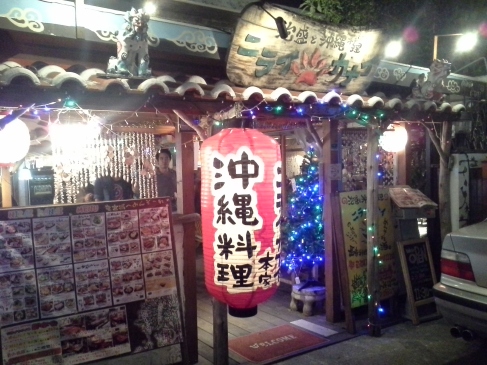
Entrance to the restaurant
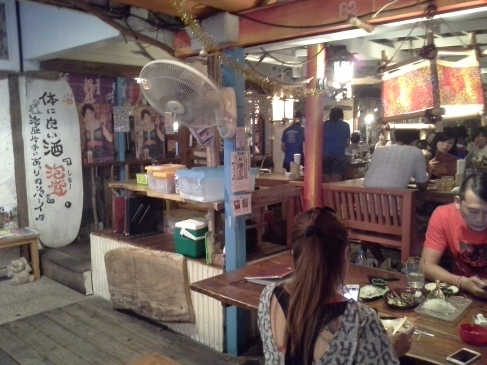
An atmosphere of your typical Japanese countryside exudes
The decor and atmosphere of the restaurant was impressively Okinawan, but what about the food?
(Very typical order from my brother).
This wasn’t a part of their ‘Okinawan-style’ food menus, but from my observation (going to Japanese every second day that is), ‘gyutataki’ is a fairly popular Japanese dish (present on the menu in most restaurants): Raw or slightly cooked thin slices of beef served with soury and sometimes spicy sauce, a sort of beef tartare.
I tried a piece of very chewy muscle filament (and truly believed our ancestors did the right thing in inventing the use of fire in cooking), and opted more for the side of the thinly sliced radish. You need a balance in everything (a life of Yin/Yang) including with food. When eating lots of meat, you’re going to need a lot of veggies or salads to counteract with the freeradicals in red meat (especially with beef). My dad has talked to many expert nutritionists, scientists, and all their opinions about beef converges to limiting its intake, because of the levels of toxins in them (certain chemicals released by the cow/bull when about to be slaughtered).
A tip for when eating red meat like beef steak is always couple it with a whole heap of salads, and perhaps wash the entire meal down with a glass of water and a capsule of vitamin C.
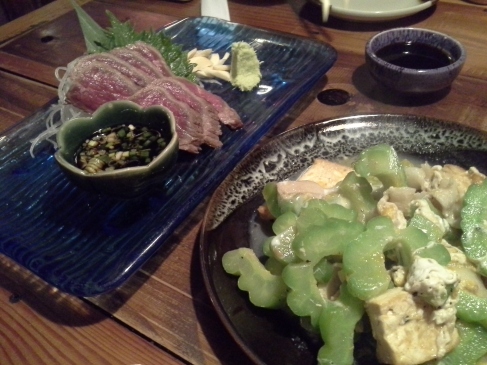
Second dish arrived shortly after. This time it was an Okinawan style stir-fry “Goya Chanpuru” – Goya (bitter gourd): bitter gourd, tofu, eggs and thin ‘shabu’ slices of pork. I like how they sauteed the entire thing using very little oil (unlike the Chinese who resolve to add even more oil on top of a dish like steamed vegetables). Instead, they probably used the moderate amount of fat emitted from the pork slices to prevent the dish from becoming too dry and bland. Twas very refreshing: The mild bitterness of bitter gourd worked together well with the sweetness from egg yolks in the eggs, and the lightness of the veggies complimented with the firm texture of tofu.
Bitter gourd were utilized in some of the dishes on their menu. I believe the Okinawan islanders’ love for bittergourd may have played a part in helping them manage diseases (that becomes more susceptible with age) like diabetes. Bitter gourd has a blood-sugar stabilizing property.
In fact, Okinawans are crazy about veggies. When you’re stuck on an island with limited resources, the last thing you would want to do is raise a cow that would soon wipe out all the grass in front of all your neighbours’ lawn, or would obliterate all the plant life that is needed to sustain life.
Plants which are much easier to take care of than animals have no doubt became a staple in the islanders’ diet (this also paralleles with other population groups within the Blue Zone whom are mostly isolated from the outside with limited resources. They are avid gardeners, self-sustainers, who obtain most of their calories from plant foods).
Despite its abundance of veggies, the Okinawan diet is not tailor-made for fat-phobic dieters:
A signature Japanese dish – tempura (a plate of deep fried battered veggies – one of the healthiest diet in the world!?). Of course, it all comes down to portion sizes and moderation.
This was a tempura made from special Okinawan seaweed called Mozuku. Nice and crispy. Using seaweed for deep fried batter makes much lighter veg tempura as compared to using i.e. carrots, sweet potatoes, etc. which resulted in a new and interesting texture.
Next, I ordered a natto dish! (I just had to do it). This time, it was a double dose of slime with some cooked okra mixed in with the already slimy enough fermented soybeans. Natto is another one of those ‘healthy’ staple of the Japanese. Chuck natto into anything and the dish becomes healthy! Afterall, they are trailed with such a bibliography of health benefits like cancer fighting properties.
Personally, I like the burst of slight saltiness tinged with mild sweetness that comes with each bite of the fermented soybeans. I don’t mind the slime much, having eaten more ‘extreme’ things out there i.e. regular intakes of fish eyes.
Grilled salmon (flesh from the belly)
The salmon belly is believed to be the most delicious part of the fish. It is also the fattiest part of the fish; full of the good fats – omega 3 fatty acids (including DHA) which is essential for your body functions, and great support for the brain functions of both old and young people. Other than this, salmon belly also has got a whole lot of collagen. Great for your skin, perfect for the ladies.
One of the main advertising ploy of this restaurant, other than ‘eating healthy’ of course, was ‘beauty’.
This brings me to the other component of Okinawan diet that is a protein – pork. The restaurant advertises its ‘Okinawan’ braised pork dish as being rich in skin-plumping collagen.
We didn’t end up ordering any pork because we’ve just had an also very collagen rich (i.e. very fatty/gelatinous) Chinese-style hog leg (the one that comes with mantou buns… drools) for lunch (that Chinese restaurant by the street served the most delicious Chinese food i.e. not too oily that I have had in Thailand).
Pigs are one of the easiest animals (for meat) to be raised because they are not selectively vegetarian or vegan. Will basically eat whatever you put in their face. Kind of like people. And so I suspect this is why islander people opt for pork and fish for their protein. One does not require a large plant crop to be raised to sustain them, and the other is basically “free food” from the generous sea.
Of course, both are eaten in very moderate amounts because they are hard to find. (Unlike in present day where everything is so available, and ironically in decline as a result; we are simply eating way too much of protein, too much of the bad things i.e. junk, refined carbs, and not enough of the good things i.e. veggies).
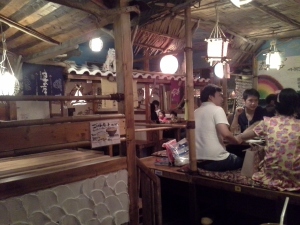
More pictures of the restaurant. Immensely popular amongst Japanese foodie and young people attempting to be healthy. We sat inside (where the aircon is).
Next, dad had to order his favourite: sweet potatoes. This time we ordered a special ‘Korean sweet potato’ which was purple. I’m sure lots of people have tried purple, other than orange sweet potato, but I’ve never had one that is entirely purple (not just on the outside)! I am guessing these potatoes would be very full of colour-indicated phytonutrients.
On another note: a major component in the Okinawan diet other than veggies is sweet potato (most likely to be Japanese rather than Korean sweet potatoes though). According to wikipedia, Okinawans obtain 69% (circa 1959) of their daily calories from the starchy vegetable. This means sweet potatoes were the main component of all their meals each day: Roughly calculated to be something like… sweet potatoes instead of toast or cereal for breakfast, sweet potatoes instead of rice at lunch, and some more sweet potatoes for dinner.
Sounds boring right? But once you’ve had organically grown steamed ‘Asian’ sweet potatoes, you will be hooked. I am currently addicted to those delicious bundle of starch and fibre (they were so expensive in New Zealand, $6.99/kg hence sweet potatoes used to be a luxury for me) Sweet potatoes are super easy to prepare: just chuck in the steamer on high for 15 minutes tops and you’ve got nice, fluffy potatoes – a healthy, low-calorie source of fibre and carbohydrate to accompany your meal.
To end the meal, we had a spinach salad with bacon bits (typical Okinawa), cherry tomatoes, and topped off with a sweet creamy sauce (I suspect it composed mainly of dairy rather than mayo – good thing it wasn’t too creamy, but quite watered down. I can trust in the Japanese to never go too overboard with dairy *Also could be because dairy is expensive here in Thailand). The salad was also sprinkled with the everpresent component in Japanese dishes like soups or noodles, bonito fish flakes. Delicious seasoning that comes with added protein.
The spinach leaves looked like they could not be eaten raw, but they were actually fine to eat. Mature, spinach leaves are not very safe to eat, because they contain a certain level of oxalic acid which in large amounts can be poisonous to the body. I suspect these spinach leaves were of a larger-leaved variety of salad spinach.
Overall, we didn’t get to try as much an array of Okinawan style foods as we wanted because there were so many other yummy dishes to try. What I have gathered from looking at the menu and from tasting some of the samples is that, Okinawan style cooking does not utilizes much oil i.e. as shown in the appearance of the stir-fry dishes; their foods are quite unrefined and simple i.e. they did not undergo an elaborate process of preparation (nutrients can be lost along the way due to heat treatment and other cooking processes): stir-fried, grilled or pan-fried, and they featured lots of both soy products i.e. tofu, and veggies.
Okinawa uses some vegetables that may not be as customary in the mainstream Japanese cuisine i.e. sea grapes (type of seaweed), bitter gourd, okra, avocado. But these very nutritious foods combined with a unique islander lifestyle is what makes Okinawan living so healthful, even beyond the Japanese diet.
I for one, with my life-long veggie addiction will probably be making a trip down the street sometime again soon to try the ‘typical Okinawan’ (they wrote on the menu) dish of “nacho rice” – rice topped with minced pork, fried egg, slices of avocado and fresh veggies; and definitely more of their selection of delicious salads.
-Izzy
